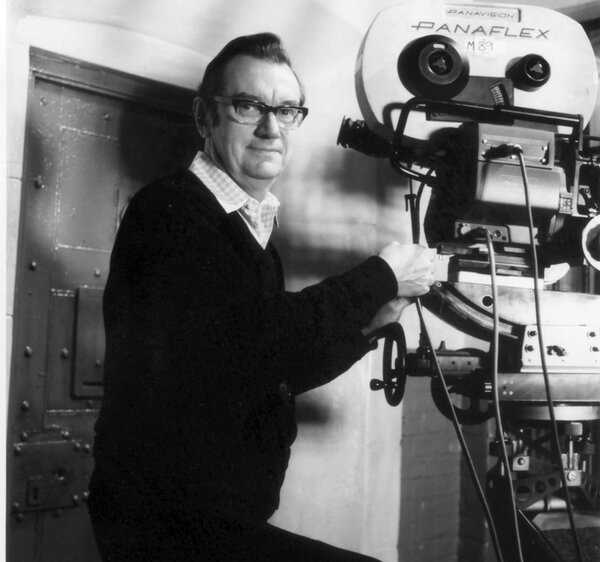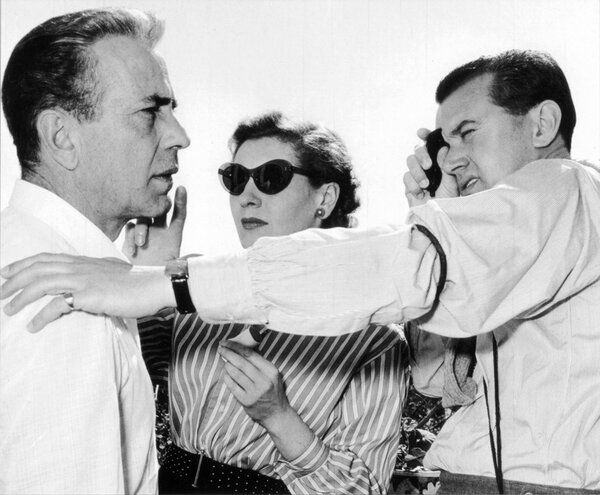"Huston, We Have a Problem - A Kaleidoscope of Filmmaking Memories"
Written by Oswald Morris and Geoffrey Bull, and presented by Marc Salomon, AFC’s consulting member
Ossie Morris first retraces the beginning of his career in the Wembley studios, starting in 1932, and on his years of apprenticeship alongside cameramen like Eric Cross, Otto Kanturek, and Ronald Neame. The beginning of the War leads to his enlisting in the RAF, where he was trained as a bomber pilot. He served for six years and conducted a number of raids above France (in October 1942 he bombed a ball-bearing factory in Le Creusot) and Germany in his “Lancaster” before being moved to transport planes and flying in North Africa behind the yoke of an “Albermarle” and then a DC3 “Dakota”. After a tour of the world with Lord Alanbrooke from October-December 1945, Morris was discharged and went back to work at the studios despite his impressive record (over 2,600 flying hours) and an attractive offer from the RAF.
Morris then began to work as a focus puller for Directors of Photography Wilkie Cooper, Ronald Neame, and Guy Green until Ronald Neame gave him his first opportunity to work as a Director of Photography in 1949 when he began to work as a director. Morris prefers to organize his career by director, rather than by date : Ronald Neame (6 movies), Carol Reed (3 movies), John Huston (8 movies) et Sidney Lumet (4 movies), followed by intermittent projects with René Clément, Tony Richardson, Stanley Kubrick, Martin Ritt, etc. The reader is obliged to follow these shifts in time. Reading this work, which is rich in professional and personal memories, tales of acquaintances and anecdotes, reveals that the first half of his career is the more varied and original : from Moulin Rouge’s “pastel” Technicolor (achieved with lots of smoke and Fog filters), to René Clément’s neo-realist approach (Knave of Hearts), to the brilliant colours of Beau Brummell (one of the first English films in Eastmancolor), to the intensive lab work needed to obtain a result close to engravings (Moby Dick, developed from a master with desaturated colours and a black-and-white master), Ossie Morris always displayed impeccable technique, classic in its inspiration and inventive in the technical prowess he was able to mobilise for each case.
From the 1960s, his filmography focused on theatrical adaptations (The Taming of the Shrew) and the adaptation of colourful and bright Brodway musicals (Oliver, Scrooge, Fiddler on the Roof, Equus, The Wiz), a period that nonetheless won him his three Oscar nominations. Two great films emerged nonetheless : The Spy Who Came In From The Cold (Martin Ritt), “one of the most beautiful black-and-white films ever made,” declared Roger Deakins, and The Man Who Would Be King (John Huston). Five lapidary and stinging pages on Kubrick (Lolita) in which Morris describes their stormy relationship. He will do his best to maintain Kubrick’s style against hell and high water, which was to take inspiration from MGM’s films from the 1930s (Morris got his hands on the Scheibe diffusers that MGM used to use) and make sure the light sources stood out (windows, lamps). “He seemed to have had a courtesy bypass because I never once heard him say ’Please’ or ’Thank you’ to anyone." But he adds, "Although it was an uneasy relationship, I tried to make allowances for this wayward behaviour because I admired his energy and brilliance so much."
Lastly, a long, vitriolic chapter tells of his problems with David O. Selznick and his legendary “Memos”. Morris was first called on by the producer in order to shoot the close ups of Jennifer Jones in Terminal Station (Vittorio de Sica, 1952). And then on Charles Vidor’s Farewell to Arms in 1957. Exasperated by Selznick’s criticisms, Morris finally threw in the towel, leaving Piero Portalupi to finish the movie. However, Selznick’s final Memo, finalizing the end of their working relationship (reproduced in the book) seems to us to be an accurate summary of the qualities and limits of Morris’ work : “Every other cameraman with whom I have ever worked, including Toland and Joe August, has taken so very much less time to light and get wonderful effects, because they light what is desired to see in the scene, and that is all. Your method seems to be to light up the whole set, what we want to see and what we don’t want to see, and then to correct it to try to get highlights on what we want to accentuate.
The result is that we get fill lighting on everything ; we don’t get the moods we are after ; and we don’t get the moulding of the faces, and the actors don’t look as well, and we don’t get the effects.”
(NB : We note in passing that Selznick, a great critic of Directors of Photography, contradicts himself in 1939 in the following Memo addressed to Lee Garmes, before firing him from Gone With The Wind : "We simply cannot tolerate any more photography that is so dark as to bewilder an audience – and that if they cannot get effect lighting without avoiding this risk, they should forget the effect lighting and light everything as tought it were a newsreel. If we can’t get artistry and clarity, let’s forget the artistry" !)
Although this is the case of many cinematographers’ autobiographies, one might regret that the author does not spend more time discussing his own work – Ossie Morris already discussed a number of his technical choices in the few interviews he has given to English-language publications since the 1970s – preferring to give his unique perspective on the films he worked on : production conditions, relationships with actors and directors, punctuated by the joys and sorrows of his personal life. He concludes by expressing reservations about current technological developments and his fear of the digital age : “I am glad to be too old to be involved.”

Selected filmography :
1949 : Golden Salamander (Ronald Neame)
1952 : Moulin Rouge (John Huston)
1953 : Beat the Devil (John Huston)
1954 : Knave of Hearts (René Clément), Beau Brummell (Curtis Bernhardt)
1955 : Moby Dick (John Huston), The Man Who Never Was (Ronald Neame)
1956 : Heaven Knows, Mr. Allison (John Huston)
1958 : The Roots of Heaven (John Huston)
1959 : Look Back in Anger (Tony Richardson), Our Man in Havana (Carol Reed)
1960 : The Guns of Navarone (J. Lee-Thompson)
1962 : Lolita (Stanley Kubrick)
1964 : The Battle of the Villa Fiorita (Delmer Daves), The Hill (Sidney Lumet)
1965 : The Spy Who Came in from the Cold (Martin Ritt)
1966 : The Taming of the Shrew (Franco Zeffirelli), Reflections in a Golden Eye (John Huston)
1968 : Oliver ! (Carol Reed)
1970 : Fiddler on the Roof (Norman Jewison)
1972 : Sleuth (Joseph L. Mankiewicz)
1973 : The Mackintosh Man (John Huston), The Odessa File (Ronald Neame)
1974 : The Man with the Golden Gun (Guy Hamilton)
1975 : The Man Who Would Be King (John Huston)
1977 : Equus (Sidney Lumet)
1979 : The Wiz (Sidney Lumet)
1981 : The Dark Crystal (Jim Henson et Franz Oz)
P.S. This book is the latest of a long list of (auto)biographies of British directors of photography :
- Jack Cardiff : Magic Hour & Conversations With J. Cardiff
- Christopher Challis : Are They Really So Awful ?
- Alan Hume : A Life Through the Lens
- Walter Lassaly : Itinerant Cameraman
- Ronald Neame : Straight from the Horse’s.
 En
En Fr
Fr





